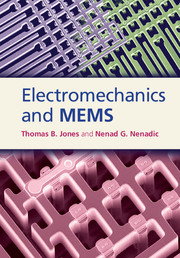Book contents
- Frontmatter
- Contents
- Preface
- 1 Introduction
- 2 Circuit-based modeling
- 3 Capacitive lumped parameter electromechanics
- 4 Small-signal capacitive electromechanical systems
- 5 Capacitive sensing and resonant drive circuits
- 6 Distributed 1-D and 2-D capacitive electromechanical structures
- 7 Practical MEMS devices
- 8 Electromechanics of piezoelectric elements
- 9 Electromechanics of magnetic MEMS devices
- Appendix A Review of quasistatic electromagnetics
- Appendix B Review of mechanical resonators
- Appendix C Micromachining
- Appendix D A brief review of solid mechanics
- Index
- References
8 - Electromechanics of piezoelectric elements
Published online by Cambridge University Press: 05 May 2013
- Frontmatter
- Contents
- Preface
- 1 Introduction
- 2 Circuit-based modeling
- 3 Capacitive lumped parameter electromechanics
- 4 Small-signal capacitive electromechanical systems
- 5 Capacitive sensing and resonant drive circuits
- 6 Distributed 1-D and 2-D capacitive electromechanical structures
- 7 Practical MEMS devices
- 8 Electromechanics of piezoelectric elements
- 9 Electromechanics of magnetic MEMS devices
- Appendix A Review of quasistatic electromagnetics
- Appendix B Review of mechanical resonators
- Appendix C Micromachining
- Appendix D A brief review of solid mechanics
- Index
- References
Summary
Introduction
The piezoelectric effect is widely exploited in actuators and sensors larger than about a millimeter. A familiar example is the crystal oscillator, which is heavily relied on as a stable frequency standard in electronics. Migrating piezomaterials into smaller scale devices has been stymied until fairly recently by serious fabrication challenges. The main problem is that the common piezoelectric solids are either ceramics or crystals, neither of which is amenable to the surface and bulk microfabrication processes used for MEMS. This situation is now starting to change. New materials and the associated microfabrication processes needed to incorporate them into submillimeter structures are being developed. Examples include thin aluminum nitride films sputtered on such substrates as Pt and crystalline Si [1]. Figure 8.1 shows some interesting and novel structures that have now been fabricated. Piezoelectric-based MEMS product lines are on the market and further entries may be anticipated.
For use as a MEMS material, piezoelectrics have compelling advantages. First, their response is linear over a large dynamic range. This attribute simplifies the requirements placed on the signal-conditioning electronics. Perhaps more importantly, piezoelectrics possess high energy densities. Because of their favorable scaling for thin film-based structures, MEMS-scale actuators and sensors using the piezoelectric effect deliver, respectively, large forces and strong signals. Furthermore, they have the practical advantage of being self-biasing, obviating the need for a DC voltage source. Finally, piezoelectric materials are generally inexpensive.
- Type
- Chapter
- Information
- Electromechanics and MEMS , pp. 372 - 398Publisher: Cambridge University PressPrint publication year: 2013



